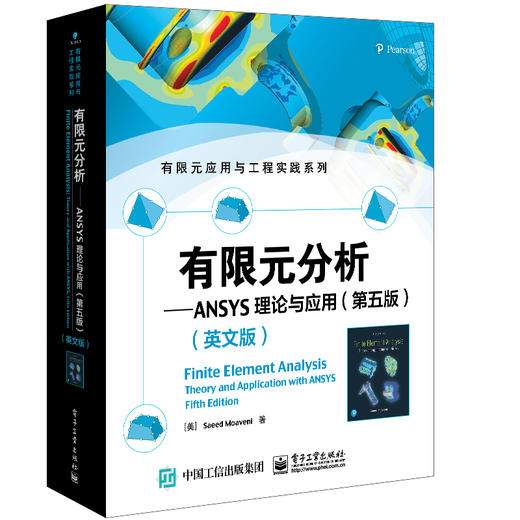商品详情
书名:有限元分析——ANSYS理论与应用(第五版)(英文版)
定价:218.0
ISBN:9787121409967
作者:(美)Saeed Moaveni(萨伊德 · 莫维尼)
版次:第1版
出版时间:2021-04
内容提要:
本书详细介绍了有限元分析的基本理论和方法,以及ANSYS软件在有限元分析中的应用。全书详细介绍了一维和二维有限元公式的推导以及实例问题的分析方法,简单阐述了三维有限元分析方法;讨论了桁架、轴力构件、梁、框架、热传递、流体流动和动力学问题的有限元分析;通过实例详细介绍了利用ANSYS进行有限元分析的基本方法和步骤。每章均先介绍相关的基本概念和有限元公式的推导过程,然后基于有限元分析方法手工求解一些简单的实例问题,进而再利用ANSYS进行问题求解。本书特别强调分析结果的验证,在一些章的章末均提出了针对不同问题的分析结果的验证方法。
作者简介:
Saeed Moaveni(萨伊德 · 莫维尼) 博士是一位成功的作者、教师与工程专家。他于1990年加入明尼苏达州立大学机械工程部,现在是机械工程学院的院长。他是美国机械工程学会(ASME)的会员和美国工程教育学会(ASEE)的Tau Beta Pi 荣誉会员。
Saeed Moaveni博士是一位成功的作者、教师与工程专家。他于1990年加入明尼苏达州立大学机械工程部,现在是机械工程学院的院长。他是美国机械工程学会(ASME)的会员和美国工程教育学会(ASEE)的Tau Beta Pi 荣誉会员。
目录:
Contents
1 Introduction 1
1.1 Engineering Problems 2
1.2 Numerical Methods 5
1.3 A Brief History of the Finite Element Method and ANSYS 6
1.4 Basic Steps in the Finite Element Method 6
1.5 Direct Formulation 8
1.6 Minimum Total Potential Energy Formulation 37
1.7 Weighted Residual Formulations 43
1.8 Verification of Results 48
1.9 Understanding the Problem 49
Summary 54
References 54
Problems 54
2 Matrix Algebra 66
2.1 Basic Definitions 66
2.2 Matrix Addition or Subtraction 69
2.3 Matrix Multiplication 69
2.4 Partitioning of a Matrix 73
2.5 Transpose of a Matrix 77
2.6 Determinant of a Matrix 81
2.7 Solutions of Simultaneous Linear Equations 86
2.8 Inverse of a Matrix 94
2.9 Eigenvalues and Eigenvectors 98
2.10 Using MATLAB to Manipulate Matrices 102
2.11 Using Excel to Manipulate Matrices 106
2.12 Solutions of Simultaneous Nonlinear Equations 121
Summary 123
References 124
Problems 124
3 Trusses 129
3.1 Definition of a Truss 129
3.2 Finite Element Formulation 130
3.3 Space Trusses 155
3.4 Overview of the ANSYS Program 157
3.5 ANSYS Workbench Environment 165
3.6 Examples Using ANSYS 165
3.7 Verification of Results 197
Summary 199
References 199
Problems 199
4 Axial Members, Beams, and Frames 209
4.1 Members Under Axial Loading 209
4.2 Beams 217
4.3 Finite Element Formulation of Beams 222
4.4 Finite Element Formulation of Frames 238
4.5 Three-Dimensional Beam Element 244
4.6 An Example Using ANSYS 246
4.7 Verification of Results 271
Summary 273
References 274
Problems 275
5 One-Dimensional Elements 287
5.1 Linear Elements 287
5.2 Quadratic Elements 291
5.3 Cubic Elements 293
5.4 Global, Local, and Natural Coordinates 296
5.5 Isoparametric Elements 298
5.6 Numerical Integration: Gauss–Legendre Quadrature 300
5.7 Examples of One-
Dimensional
Elements in ANSYS 305
Summary 305
References 305
Problems 305
6 Analysis of One-Dimensional Problems 312
6.1 Heat Transfer Problems 312
6.2 A Fluid Mechanics Problem 331
6.3 An Example Using ANSYS 335
6.4 Verification of Results 350
6.5 Members Under Axial Loading with Temperature Change 351
Summary 353
References 353
Problems 353
7 Two-Dimensional Elements 357
7.1 Rectangular Elements 357
7.2 Quadratic Quadrilateral Elements 361
7.3 Linear Triangular Elements 366
7.4 Quadratic Triangular Elements 371
7.5 Axisymmetric Elements 375
7.6 Isoparametric Elements 380
7.7 Two-Dimensional Integrals: Gauss–Legendre Quadrature 383
7.8 Examples of Two-Dimensional Elements in ANSYS 384
Summary 385
References 385
Problems 386
8 More ANSYS 393
8.1 ANSYS Program 393
8.2 ANSYS Database and Files 394
8.3 Creating a Finite Element Model with ANSYS: Preprocessing 396
8.4 h-Method Versus p-Method 410
8.5 Applying Boundary Conditions, Loads, and the Solution 410
8.6 Results of Your Finite Element Model: Postprocessing 413
8.7 Selection Options 418
8.8 Graphics Capabilities 419
8.9 Error-Estimation Procedures 421
8.10 More on ANSYS Workbench Environment 422
8.11 An Example Problem 428
Summary 441
References 442
9 Analysis of Two-Dimensional Heat Transfer Problems 443
9.1 General Conduction Problems 443
9.2 Formulation with Rectangular Elements 450
9.3 Formulation with Triangular Elements 461
9.4 Axisymmetric Formulation of Three-Dimensional Problems 480
9.5 Unsteady Heat Transfer 487
9.6 Conduction Elements Used by ANSYS 497
9.7 Examples Using ANSYS 498
9.8 Verification of Results 538
Summary 538
References 540
Problems 540
10 Analysis of Two-Dimensional Solid Mechanics Problems 552
10.1 Torsion of Members with Arbitrary Cross-Section Shape 552
10.2 Plane-Stress Formulation 568
10.3 Isoparametric Formulation: Using a Quadrilateral Element 576
10.4 Axisymmetric Formulation 583
10.5 Basic Failure Theories 585
10.6 Examples Using ANSYS 586
10.7 Verification of Results 608
Summary 608
References 610
Problems 610
11 Dynamic Problems 619
11.1 Review of Dynamics 619
11.2 Review of Vibration of Mechanical and Structural Systems 633
11.3 Lagrange’s Equations 650
11.4 Finite Element Formulation of Axial Members 652
11.5 Finite Element Formulation of Beams and Frames 661
11.6 Examples Using ANSYS 675
Summary 694
References 694
Problems 694
12 Analysis of Fluid Mechanics Problems 701
12.1 Direct Formulation of Flow Through Pipes 701
12.2 Ideal Fluid Flow 713
12.3 Groundwater Flow 719
12.4 Examples Using ANSYS 722
12.5 Verification of Results 743
Summary 744
References 745
Problems 746
13 Three-Dimensional Elements 751
13.1 The Four-Node Tetrahedral Element 751
13.2 Analysis of Three-Dimensional Solid Problems Using Four-Node Tetrahedral Elements 754
13.3 The Eight-Node Brick Element 759
13.4 The Ten-Node Tetrahedral Element 761
13.5 The Twenty-Node Brick Element 762
13.6 Examples of Three-Dimensional Elements in ANSYS 764
13.7 Basic Solid-Modeling Ideas 768
13.8 A Thermal Example Using ANSYS 779
13.9 A Structural Example Using ANSYS 796
Summary 809
References 809
Problems 809
14 Design and Material Selection 818
14.1 Engineering Design Process 819
14.2 Material Selection 822
14.3 Electrical, Mechanical, and Thermophysical Properties of Materials 823
14.4 Common Solid Engineering Materials 825
14.5 Some Common Fluid Materials 832
Summary 834
References 834
Problems 834
15 Design Optimization 836
15.1 Introduction to Design Optimization 836
15.2 The Parametric Design Language of ANSYS 840
15.3 Examples of Batch Files 842
Summary 853
References 854
Problems 854
Appendix A Mechanical Properties of Some Materials 855
Appendix B Thermophysical Properties of Some Materials 859
Appendix C Properties of Common Line and Area Shapes 861
Appendix D Geometrical Properties of Structural Steel Shapes 865
Appendix E Conversion Factors 869
Appendix F An Introduction to MATLAB 871
Appendix G Workbench Examples 905
定价:218.0
ISBN:9787121409967
作者:(美)Saeed Moaveni(萨伊德 · 莫维尼)
版次:第1版
出版时间:2021-04
内容提要:
本书详细介绍了有限元分析的基本理论和方法,以及ANSYS软件在有限元分析中的应用。全书详细介绍了一维和二维有限元公式的推导以及实例问题的分析方法,简单阐述了三维有限元分析方法;讨论了桁架、轴力构件、梁、框架、热传递、流体流动和动力学问题的有限元分析;通过实例详细介绍了利用ANSYS进行有限元分析的基本方法和步骤。每章均先介绍相关的基本概念和有限元公式的推导过程,然后基于有限元分析方法手工求解一些简单的实例问题,进而再利用ANSYS进行问题求解。本书特别强调分析结果的验证,在一些章的章末均提出了针对不同问题的分析结果的验证方法。
作者简介:
Saeed Moaveni(萨伊德 · 莫维尼) 博士是一位成功的作者、教师与工程专家。他于1990年加入明尼苏达州立大学机械工程部,现在是机械工程学院的院长。他是美国机械工程学会(ASME)的会员和美国工程教育学会(ASEE)的Tau Beta Pi 荣誉会员。
Saeed Moaveni博士是一位成功的作者、教师与工程专家。他于1990年加入明尼苏达州立大学机械工程部,现在是机械工程学院的院长。他是美国机械工程学会(ASME)的会员和美国工程教育学会(ASEE)的Tau Beta Pi 荣誉会员。
目录:
Contents
1 Introduction 1
1.1 Engineering Problems 2
1.2 Numerical Methods 5
1.3 A Brief History of the Finite Element Method and ANSYS 6
1.4 Basic Steps in the Finite Element Method 6
1.5 Direct Formulation 8
1.6 Minimum Total Potential Energy Formulation 37
1.7 Weighted Residual Formulations 43
1.8 Verification of Results 48
1.9 Understanding the Problem 49
Summary 54
References 54
Problems 54
2 Matrix Algebra 66
2.1 Basic Definitions 66
2.2 Matrix Addition or Subtraction 69
2.3 Matrix Multiplication 69
2.4 Partitioning of a Matrix 73
2.5 Transpose of a Matrix 77
2.6 Determinant of a Matrix 81
2.7 Solutions of Simultaneous Linear Equations 86
2.8 Inverse of a Matrix 94
2.9 Eigenvalues and Eigenvectors 98
2.10 Using MATLAB to Manipulate Matrices 102
2.11 Using Excel to Manipulate Matrices 106
2.12 Solutions of Simultaneous Nonlinear Equations 121
Summary 123
References 124
Problems 124
3 Trusses 129
3.1 Definition of a Truss 129
3.2 Finite Element Formulation 130
3.3 Space Trusses 155
3.4 Overview of the ANSYS Program 157
3.5 ANSYS Workbench Environment 165
3.6 Examples Using ANSYS 165
3.7 Verification of Results 197
Summary 199
References 199
Problems 199
4 Axial Members, Beams, and Frames 209
4.1 Members Under Axial Loading 209
4.2 Beams 217
4.3 Finite Element Formulation of Beams 222
4.4 Finite Element Formulation of Frames 238
4.5 Three-Dimensional Beam Element 244
4.6 An Example Using ANSYS 246
4.7 Verification of Results 271
Summary 273
References 274
Problems 275
5 One-Dimensional Elements 287
5.1 Linear Elements 287
5.2 Quadratic Elements 291
5.3 Cubic Elements 293
5.4 Global, Local, and Natural Coordinates 296
5.5 Isoparametric Elements 298
5.6 Numerical Integration: Gauss–Legendre Quadrature 300
5.7 Examples of One-
Dimensional
Elements in ANSYS 305
Summary 305
References 305
Problems 305
6 Analysis of One-Dimensional Problems 312
6.1 Heat Transfer Problems 312
6.2 A Fluid Mechanics Problem 331
6.3 An Example Using ANSYS 335
6.4 Verification of Results 350
6.5 Members Under Axial Loading with Temperature Change 351
Summary 353
References 353
Problems 353
7 Two-Dimensional Elements 357
7.1 Rectangular Elements 357
7.2 Quadratic Quadrilateral Elements 361
7.3 Linear Triangular Elements 366
7.4 Quadratic Triangular Elements 371
7.5 Axisymmetric Elements 375
7.6 Isoparametric Elements 380
7.7 Two-Dimensional Integrals: Gauss–Legendre Quadrature 383
7.8 Examples of Two-Dimensional Elements in ANSYS 384
Summary 385
References 385
Problems 386
8 More ANSYS 393
8.1 ANSYS Program 393
8.2 ANSYS Database and Files 394
8.3 Creating a Finite Element Model with ANSYS: Preprocessing 396
8.4 h-Method Versus p-Method 410
8.5 Applying Boundary Conditions, Loads, and the Solution 410
8.6 Results of Your Finite Element Model: Postprocessing 413
8.7 Selection Options 418
8.8 Graphics Capabilities 419
8.9 Error-Estimation Procedures 421
8.10 More on ANSYS Workbench Environment 422
8.11 An Example Problem 428
Summary 441
References 442
9 Analysis of Two-Dimensional Heat Transfer Problems 443
9.1 General Conduction Problems 443
9.2 Formulation with Rectangular Elements 450
9.3 Formulation with Triangular Elements 461
9.4 Axisymmetric Formulation of Three-Dimensional Problems 480
9.5 Unsteady Heat Transfer 487
9.6 Conduction Elements Used by ANSYS 497
9.7 Examples Using ANSYS 498
9.8 Verification of Results 538
Summary 538
References 540
Problems 540
10 Analysis of Two-Dimensional Solid Mechanics Problems 552
10.1 Torsion of Members with Arbitrary Cross-Section Shape 552
10.2 Plane-Stress Formulation 568
10.3 Isoparametric Formulation: Using a Quadrilateral Element 576
10.4 Axisymmetric Formulation 583
10.5 Basic Failure Theories 585
10.6 Examples Using ANSYS 586
10.7 Verification of Results 608
Summary 608
References 610
Problems 610
11 Dynamic Problems 619
11.1 Review of Dynamics 619
11.2 Review of Vibration of Mechanical and Structural Systems 633
11.3 Lagrange’s Equations 650
11.4 Finite Element Formulation of Axial Members 652
11.5 Finite Element Formulation of Beams and Frames 661
11.6 Examples Using ANSYS 675
Summary 694
References 694
Problems 694
12 Analysis of Fluid Mechanics Problems 701
12.1 Direct Formulation of Flow Through Pipes 701
12.2 Ideal Fluid Flow 713
12.3 Groundwater Flow 719
12.4 Examples Using ANSYS 722
12.5 Verification of Results 743
Summary 744
References 745
Problems 746
13 Three-Dimensional Elements 751
13.1 The Four-Node Tetrahedral Element 751
13.2 Analysis of Three-Dimensional Solid Problems Using Four-Node Tetrahedral Elements 754
13.3 The Eight-Node Brick Element 759
13.4 The Ten-Node Tetrahedral Element 761
13.5 The Twenty-Node Brick Element 762
13.6 Examples of Three-Dimensional Elements in ANSYS 764
13.7 Basic Solid-Modeling Ideas 768
13.8 A Thermal Example Using ANSYS 779
13.9 A Structural Example Using ANSYS 796
Summary 809
References 809
Problems 809
14 Design and Material Selection 818
14.1 Engineering Design Process 819
14.2 Material Selection 822
14.3 Electrical, Mechanical, and Thermophysical Properties of Materials 823
14.4 Common Solid Engineering Materials 825
14.5 Some Common Fluid Materials 832
Summary 834
References 834
Problems 834
15 Design Optimization 836
15.1 Introduction to Design Optimization 836
15.2 The Parametric Design Language of ANSYS 840
15.3 Examples of Batch Files 842
Summary 853
References 854
Problems 854
Appendix A Mechanical Properties of Some Materials 855
Appendix B Thermophysical Properties of Some Materials 859
Appendix C Properties of Common Line and Area Shapes 861
Appendix D Geometrical Properties of Structural Steel Shapes 865
Appendix E Conversion Factors 869
Appendix F An Introduction to MATLAB 871
Appendix G Workbench Examples 905
- 电子工业出版社有限公司
- 电子工业出版社有限公司有赞官方供货商,为客户提供一流的知识产品及服务。
- 扫描二维码,访问我们的微信店铺











